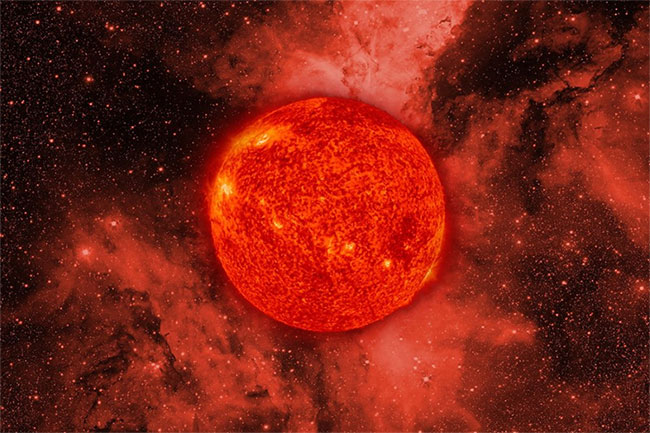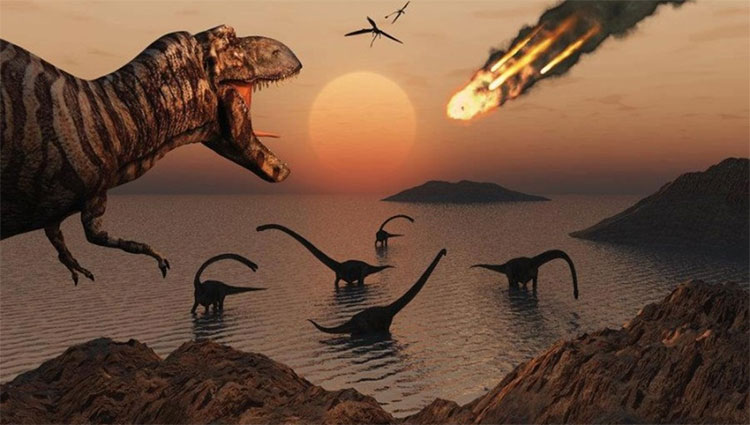The Sun's search for a twin brother
Most stars in the universe have pairs, and our Sun may also have another twin at the time of its formation, but the star has yet to be found.
In the 1980s, physicist Richard Muller at the University of California, Berkeley presented the idea of one of us, calling it "Nemesis " and thought it was the cause of asteroids colliding. Earth by strong gravity from it.

Is our Sun missing a twin brother from the beginning?(Photo: NASA images / Shutterstock).
Most of the vertebrate species that once lived on Earth suddenly disappeared and became extinct about 66 million years ago, including dinosaurs. An asteroid of the size of a modern city that has impacted the Earth caused this great extinction event.
This event, also known as the Chicxulub Event , has caused the Earth's temperature to drop deeply, triggering a series of volcanoes across the globe to erupt and transform the entire face of the blue planet. This event is believed by Richard Muller to be caused by an asteroid, which is affected by the gravity of Nemesis.
The events of extinction on Earth in the past occurred regularly, which led scientists to believe that asteroids themselves were the cause, because they had a fixed orbit and would collide. Touch the Earth at a time that is repeated after each cycle.

The extinction event erased very likely dinosaurs caused by a meteorite affected by Nemesis gravity.(Photo: Futurism).
Based on these, a study was conducted in 2017 by researchers at the University of California who came up with the idea that stars when formed had a companion. This study modeled when stars were formed from dense dust clouds, based on a realistic survey of the giant gas cloud in the constellation Perseus. Simulation models show that stars are formed in pairs.
'Studies of star formation in the constellation Perseus show us that all stars the size of our Sun are formed in pairs. That is, our Sun was once a member of a binary star system. These two stars then gradually separated from each other and gave themselves a way, ' said Douglas Vakoch, director of nonprofit Messaging Extraterrestrial Intelligence.
Nemesis hypothesis
In presenting his idea of Nemesis, Muller acknowledged that the remaining star of the "solar binary star" had wandered into the Solar System and left when crossing Oort Cloud - a dense crowd of icy object near the outermost of the Solar System, it is located outside Pluto and.
When passing here, the heat of this second star causes the icy objects here to heat up and melt, forming a tail and we call it a comet. Nemesis's intriguing interaction affects the comets here, causing them to bend the direction and move deep into the Solar System, on their way to Earth.

The mysterious star Nemesis before leaving the Sun, passed through the Oort Cloud disturbing the trajectory of the objects there.(Photo: TellMyFacts).
If Nemesis passes through the Oort Cloud every 27 million years, then we will have five major extinctions that have occurred on Earth. These events include the deregulation of dinosaurs, the massive extinction event of 251 million years ago, which caused 96% of species to disappear and the extinction event that took place in 375 million years ago, causing 75% of species to be erased. complete book.
In the 1980s when presenting this idea, Muller said the technology at the time was not advanced enough to find and observe the Nemesis star.
Looking for the Nemesis
Although the Sun was formed at the same time as the twin sister Nemesis, there were no scientific explanations that the star was trapped inside the Solar System and devastated the environment within the planetary system. this.
Muller's hypothesis suggests that Nemesis may be 1.5 light-years away from our Sun (modern tools have allowed us to observe this distance). But so far, every attempt to find Nemesis has failed.
After detecting millions of objects in the Solar System, the telescope explores the Wide Field Infrared Detector and Survey (Wide-Field Infrared Survey Explorer, or WISE), without finding any evidence of A twin star with the Sun.
Speaking after the search campaign ended, a NASA spokesman said: 'Perhaps Nemesis' existence is just an outdated hypothesis that has been rejected by contemporary experts.'

According to the latest research, most of the Sun-like stars will be formed in pairs.This means that the Sun is still missing a twin brother.(Photo: ZME Science).
But without stopping there, many other scientists continue to study the existence of Nemesis by investigating other clues. Physicist Adrian Melott and paleontologist Richard Bambach have been constantly analyzing fossils dating to half a billion years of age on Earth, from which there is always an extinction event taking place every 27 million years. .
According to their research published in the Royal Society's publication, they modeled the orbits of objects on the edge of the Solar System and showed that they were subjected to a certain amount of trajectory, 'The trajectories of these objects are disturbed by a larger object, which does not exclude it as Nemesis'.
Mordecai-Mark Mac Low, head of the Astrophysics Department of the American Museum of Natural History, has a similar idea. He said: 'There is more evidence that Nemesis' existence than arguments against it. Although we have not yet observed a clear sign, what it leaves due to gravitational interaction on small objects in the Solar System helps us think so. "
Anyway, the star formed with the Sun from the beginning was quickly removed and drifted into the free space of hundreds of billions of other stars in the Milky Way. Direct observation of this star is probably never done.
- Top 15 strange natural phenomena (2)
- Multifaceted mosaic - when a twin brother exists inside your own body
- There is a twin sister who is difficult to marry
- Hypothesis of the lost brother of the Sun.
- Video: 3 suns together in Russia
- NASA's twin astronaut experiment
- Hypothesis of the fate of the Earth if the universe exists 2 Sun.
- Discovered a strange planet with 3 Suns in the summer that lasted up to 300 years
- For the first time, the planet has 4 suns
- Plutonium: The twin brother of Uranium
- The fake life in the solar system has 2 suns?
- Kangaroo is a rare twin in Australia
 Van Allen's belt and evidence that the Apollo 11 mission to the Moon was myth
Van Allen's belt and evidence that the Apollo 11 mission to the Moon was myth The levels of civilization in the universe (Kardashev scale)
The levels of civilization in the universe (Kardashev scale) Today Mars, the sun and the Earth are aligned
Today Mars, the sun and the Earth are aligned The Amazon owner announced a secret plan to build a space base for thousands of people
The Amazon owner announced a secret plan to build a space base for thousands of people